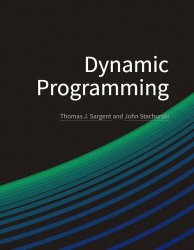Dynamic Programming Volume I: Finite States
- Добавил: literator
- Дата: 5-01-2024, 16:48
- Комментариев: 0
 Название: Dynamic Programming Volume I: Finite States
Название: Dynamic Programming Volume I: Finite StatesАвтор: Thomas J. Sargent, John Stachurski
Издательство: QuantEcon
Год: December 4, 2023
Страниц: 443
Язык: английский
Формат: pdf (true)
Размер: 10.1 MB
This book is about dynamic programming and its applications in economics, finance, and adjacent fields like operations research. It brings together recent innovations in the theory of dynamic programming and also provides related applications and computer code.
Chapters 1–3 provide motivation and background material on solving fixed point problems and computing lifetime valuations. Chapters 4 and 5 cover optimal stopping and Markov decision processes respectively. Chapter 6 extends the Markov decision framework to settings where discount rates vary over time. Chapter 7 treats recursive preferences. The main theoretical results on dynamic programming from Chapters 4–6 are special cases of the general results in Chapters 8–9. A brief discussion of continuous time models can be found in Chapter 10.
Mathematically inclined readers with some background in dynamic programming might prefer to start with the general results in Chapters 8–9. Indeed, it is possible to read the text in reverse, jumping to Chapters 8–9 and then moving back to cover special cases according to interests. However, our teaching experience tells us thatmost students find the general results challenging on first pass, but considerably easier after they have practiced dynamic programming through the earlier chapters. This is why the presentation starts with special cases and ends with general results.
One feature of the text is that computer code is a first-class citizen. The code embedded in the textbook is written in Julia and can be found at GitHub. We chose Julia because it is open source and because Julia allows us to write computer code that is as close as possible to the relevant mathematical equations. Julia code in the text is written to maximize clarity rather than speed. We have also written matching Python code, which can be found in the same repository. While Python is very practical and efficient for dynamic programming—when combined with the right scientific libraries—implementations are sometimes not as clean as Julia, and tend to be library specific. That is why we chose Julia for programs embedded in the text.
Topics:
Fixed points and order
Markov models
Optimal stopping
Markov decision processes
State dependent discounting
Nonlinear valuation
Abstract dynamic programming
Скачать Dynamic Programming Volume I: Finite States
Внимание
Уважаемый посетитель, Вы зашли на сайт как незарегистрированный пользователь.
Мы рекомендуем Вам зарегистрироваться либо войти на сайт под своим именем.
Уважаемый посетитель, Вы зашли на сайт как незарегистрированный пользователь.
Мы рекомендуем Вам зарегистрироваться либо войти на сайт под своим именем.
Информация
Посетители, находящиеся в группе Гости, не могут оставлять комментарии к данной публикации.
Посетители, находящиеся в группе Гости, не могут оставлять комментарии к данной публикации.
